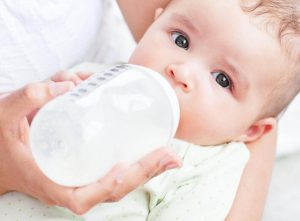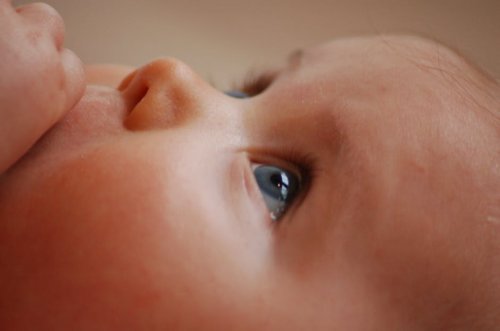The Evolution of Children's Sense of Sight

Sight is the most influential sense in human perception. With it, we perceive shapes, colors, distance, size, and many other characteristics of the reality around us.
The organs involved in sight are our eyes. Our eyes are composed of two incredibly fragile spheres situated in the front of our faces. Their anatomy is very complex and consists of several different parts. Each part of our eyes has a specific purpose, be it protection or function.
Just as any other organ or sense in our bodies, our eyes have a gradual development. As babies grow and mature, their vision becomes more defined. At about 8 or 9 months of age, we can say that a child‘s vision is fully developed.
The evolution of children’s sense of sight
The sense of sight in newborn babies
The senses of touch, hearing, smell and taste are all almost completely developed when a child is born. However, the sense of sight takes longer to reach its full potential.
During children’s first month of life, the brain isn’t yet prepared to process all of the information that the eyes send.
Therefore, their vision is blurry, with very little definition. This means small babies may have difficulty coordinating their movements with their vision.
Don’t worry if, from time to time, your child goes cross-eyed or his or her eyes drift off to one side or the other. Over the next few weeks, your baby will learn to focus his or her vision.

The following months
Beginning at the second month of life, children’s sense of sight allows them to distinguish between colors.
Gradually, you’ll notice how your child pays more attention to brighter and bolder colors. At the same time, your child’s ability to follow an object with his or her eyes will improve.
Starting around the end of the third month of life, babies begin to move their hands and grasp objects. This is thanks to their incipient motor coordination. Furthermore, the increased development of neural circuits allows them to distinguish shapes and other characteristics of objects they hold.
From the fifth month on, children’s sense of sight allows them to better distinguish shapes. This means they can better appreciate small objects and their colors.
In just a few weeks, the child’s sight will reach its maximum development. Finally, your little one will be able to see people and objects at a further distance.
How to care for your child’s vision?
Of course, periodic visits to your child’s pediatrician as well as your family opthamologist are important. In addition, there are certain recommendations that you can put into practice to care for your child’s eyesight.
First of all, as in so many other areas, proper nutrition is key. A healthy daily diet that is rich in vitamins – especially vitamin A – will keep your child’s vision in good shape.
“Their anatomy is very complex and consists of several different parts. Each part of our eyes has a specific purpose, be it protection or function.”
At the same time, it’s important that we limit the amount of time our children spend in front of screens.
Here, we’re referring not only to television, but also computers, tablets and cell phones. And of course, when your children are having screen time, you should make sure they keep their distance.
Finally, invest in a good pair of sunglasses with UV protection. This is fundamental in protecting your child’s eyes against the damaging effects of prolonged sun exposure. Using sunglasses isn’t about making a fashion statement – they’re a necessity.

Vision problems in children
The following problems may be an indication that something is wrong with your child’s vision. You should take your child in for a medical consult if he or she is experiencing any of the symptoms below:
- Lack of coordination
- Difficulty recognizing shapes – whether they be nearby or far away
- Headache
- Itchy eyes
- Constant dry eyes
As for babies, you should watch out for the following red flags and discuss them with your pediatrician if they appear:
- Your baby is unable to follow objects with his or her eyes at 3 months of age.
- One or both eyes don’t move in a particular direction.
- Your baby is unable to keep his or her eyes fixed in one spot.
- Stains or discoloration of the pupils.
Finally, you should keep in mind that there are other factors that can predispose children to vision problems.
These may be genetic – especially if another family member has experienced them – or they may be pathological. This last category includes accidents, trauma, and exposition to harmful stimuli.
Sight is the most influential sense in human perception. With it, we perceive shapes, colors, distance, size, and many other characteristics of the reality around us.
The organs involved in sight are our eyes. Our eyes are composed of two incredibly fragile spheres situated in the front of our faces. Their anatomy is very complex and consists of several different parts. Each part of our eyes has a specific purpose, be it protection or function.
Just as any other organ or sense in our bodies, our eyes have a gradual development. As babies grow and mature, their vision becomes more defined. At about 8 or 9 months of age, we can say that a child‘s vision is fully developed.
The evolution of children’s sense of sight
The sense of sight in newborn babies
The senses of touch, hearing, smell and taste are all almost completely developed when a child is born. However, the sense of sight takes longer to reach its full potential.
During children’s first month of life, the brain isn’t yet prepared to process all of the information that the eyes send.
Therefore, their vision is blurry, with very little definition. This means small babies may have difficulty coordinating their movements with their vision.
Don’t worry if, from time to time, your child goes cross-eyed or his or her eyes drift off to one side or the other. Over the next few weeks, your baby will learn to focus his or her vision.

The following months
Beginning at the second month of life, children’s sense of sight allows them to distinguish between colors.
Gradually, you’ll notice how your child pays more attention to brighter and bolder colors. At the same time, your child’s ability to follow an object with his or her eyes will improve.
Starting around the end of the third month of life, babies begin to move their hands and grasp objects. This is thanks to their incipient motor coordination. Furthermore, the increased development of neural circuits allows them to distinguish shapes and other characteristics of objects they hold.
From the fifth month on, children’s sense of sight allows them to better distinguish shapes. This means they can better appreciate small objects and their colors.
In just a few weeks, the child’s sight will reach its maximum development. Finally, your little one will be able to see people and objects at a further distance.
How to care for your child’s vision?
Of course, periodic visits to your child’s pediatrician as well as your family opthamologist are important. In addition, there are certain recommendations that you can put into practice to care for your child’s eyesight.
First of all, as in so many other areas, proper nutrition is key. A healthy daily diet that is rich in vitamins – especially vitamin A – will keep your child’s vision in good shape.
“Their anatomy is very complex and consists of several different parts. Each part of our eyes has a specific purpose, be it protection or function.”
At the same time, it’s important that we limit the amount of time our children spend in front of screens.
Here, we’re referring not only to television, but also computers, tablets and cell phones. And of course, when your children are having screen time, you should make sure they keep their distance.
Finally, invest in a good pair of sunglasses with UV protection. This is fundamental in protecting your child’s eyes against the damaging effects of prolonged sun exposure. Using sunglasses isn’t about making a fashion statement – they’re a necessity.

Vision problems in children
The following problems may be an indication that something is wrong with your child’s vision. You should take your child in for a medical consult if he or she is experiencing any of the symptoms below:
- Lack of coordination
- Difficulty recognizing shapes – whether they be nearby or far away
- Headache
- Itchy eyes
- Constant dry eyes
As for babies, you should watch out for the following red flags and discuss them with your pediatrician if they appear:
- Your baby is unable to follow objects with his or her eyes at 3 months of age.
- One or both eyes don’t move in a particular direction.
- Your baby is unable to keep his or her eyes fixed in one spot.
- Stains or discoloration of the pupils.
Finally, you should keep in mind that there are other factors that can predispose children to vision problems.
These may be genetic – especially if another family member has experienced them – or they may be pathological. This last category includes accidents, trauma, and exposition to harmful stimuli.
All cited sources were thoroughly reviewed by our team to ensure their quality, reliability, currency, and validity. The bibliography of this article was considered reliable and of academic or scientific accuracy.
- Healthy Children staff. (n.d.). El desarrollo de la visión del bebé: ¿qué pueden ver los bebés? American Academy of Pediatrics. https://www.healthychildren.org/Spanish/ages-stages/baby/Paginas/babys-vision-development.aspx
This text is provided for informational purposes only and does not replace consultation with a professional. If in doubt, consult your specialist.








